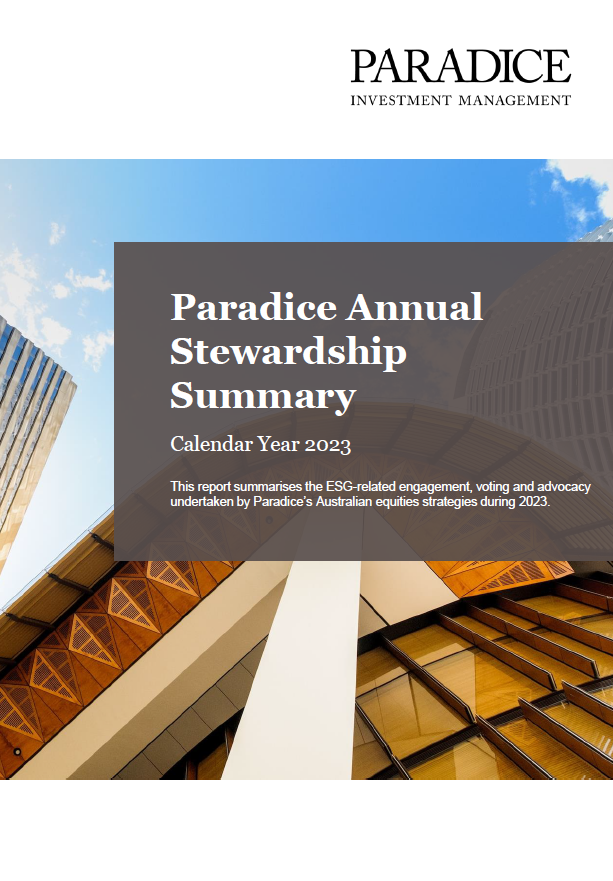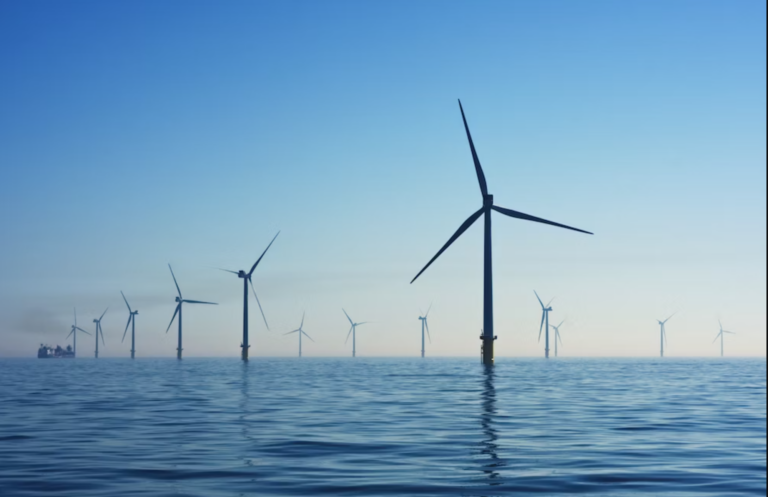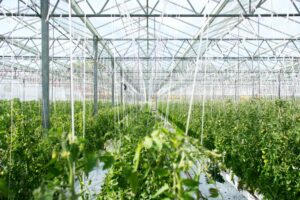Paradice publishes stewardship summary report for 2023
We’re pleased to publish our second report summarising the Australian equities teams’ stewardship-related activity undertaken in 2023. This includes ESG-related engagement with investee companies, how we exercised our voting rights, and highlights from our advocacy and collaborative efforts.
Collectively in 2023, the Australian equities teams held 167 ESG-related engagements with 71 companies. Transition risks relating to climate change dominated engagement during the year, with a total of 109 engagements on this topic. The next most common topic was environmental management, with 48 engagements. The report not only provides key statistics but offers some insights into how we engage at both a company level and through topic-specific programs through case study examples.
We also lay out some key statistics around this year’s voting activity, and highlight some actions taken with respect to advocacy and our participation in collaborative investor initiatives.
Read the Paradice Annual Stewardship Summary here
Disclaimer:
This material is prepared by Paradice Investment Management Pty Ltd (ABN 64 090 148 619, AFSL No. 224158) (“Paradice”, “we” or “us”).
This material is not intended to constitute advertising or advice (including investment advice or security, market or sector recommendations) of any kind.
This material is not to be copied, reproduced or published at any time without the prior written consent of Paradice.
The information herein is intended to provide an indication of the engagement activity undertaken by the investment teams responsible for managing Australian equities. The material presented contains information derived from the various portfolios managed by Paradice, including, but not limited to, Paradice Australian Equities Fund (ARSN 617 679 071), Paradice Australian Mid Cap Fund (ARSN 620 055 138), Paradice Australian Small Cap Fund (ARSN 620 056 091), Paradice Equity Alpha Plus Fund (ARSN 631 044 678), and Paradice Australian Small Cap Opportunities Fund (ARSN 667 664 137) (together “the Paradice Funds”).
Equity Trustees Limited (“Equity Trustees”) (ABN 46 004 031 298), AFSL 240975, is the Responsible Entity for the Paradice Funds. Equity Trustees is a subsidiary of EQT Holdings Limited (ABN 22 607 797 615), a publicly listed company on the Australian Securities Exchange (ASX: EQT).
The information and opinions contained herein, including information obtained from third party sources which are considered to be reliable, are not necessarily all-inclusive and, as such, no representation or warranty, express or implied, is made as to the accuracy, completeness or reasonableness of any assumption contained herein and no responsibility arising for errors and omissions (including responsibility to any person by reason of negligence) is accepted by Paradice, its officers, employees or agents.
Any specific securities identified herein are not representative of all securities purchased, sold, or recommended by Paradice.
In addition, the information, analysis, and opinions expressed herein are for general and educational purposes only.
In preparing this material we did not take into account the investment objectives, financial situation or particular needs of any particular person. It is not intended to take the place of professional advice and you should not take action on specific issues in reliance on this information. Neither Paradice, Equity Trustees nor any of its related parties, their employees or directors, provide and warranty of accuracy or reliability in relation to such information or accepts any liability to any person who relies on it. Past performance should not be taken as an indicator of future performance. You should obtain a copy of the Product Disclosure Statement for any relevant Paradice Fund before making a decision about whether to invest in the product.
The Target Market Determinations for the Paradice Funds are available here: https://paradice.com/au/investor-centre/. A Target Market Determination is a document which is required to be made available from 5 October 2021. It describes who this financial product is likely to be appropriate for (i.e. the target market), and any conditions around how the product can be distributed to investors. It also describes the events or circumstances where the Target Market Determination for this financial product may need to be reviewed.
ESG considerations may vary across investments, and not every ESG factor may be identified or evaluated for every investment. There is no guarantee that the evaluation of ESG characteristics will be additive to a strategy’s performance. ESG is not a uniformly-defined characteristic and information used to evaluate ESG characteristics may not be readily available, complete, or accurate, and may vary across providers and issuers. Because of the subjective nature of ESG assessment, there can be no guarantee that ESG factors considered will reflect the beliefs or values of any particular client / investor.
The services described may not be suitable for or offered to all investors and investors should consult with an investment advisor to determine the appropriate investment strategy. All investments carry a certain risk, and there is no assurance that an investment, strategy, or approach will provide positive performance over any period of time. There is no guarantee that an investment in any strategy offered has or will be profitable. Strategies are actively managed and subject to change. Additional important risk disclosures can be found here for Paradice https://www.paradice.com/au/terms-conditions/.
Any forecasts or estimates contained in this publication are not guaranteed. It is of a general nature only and was current only at the time of initial publication.








Comments